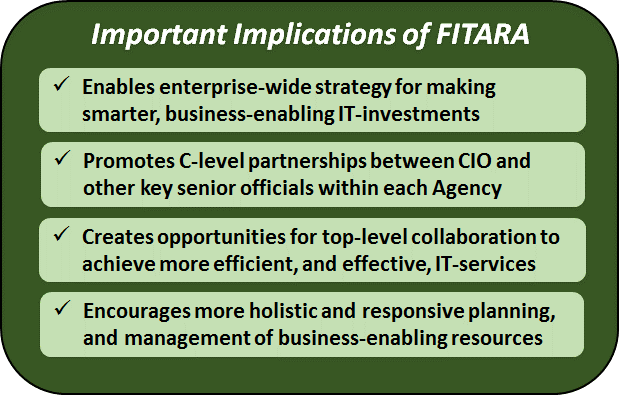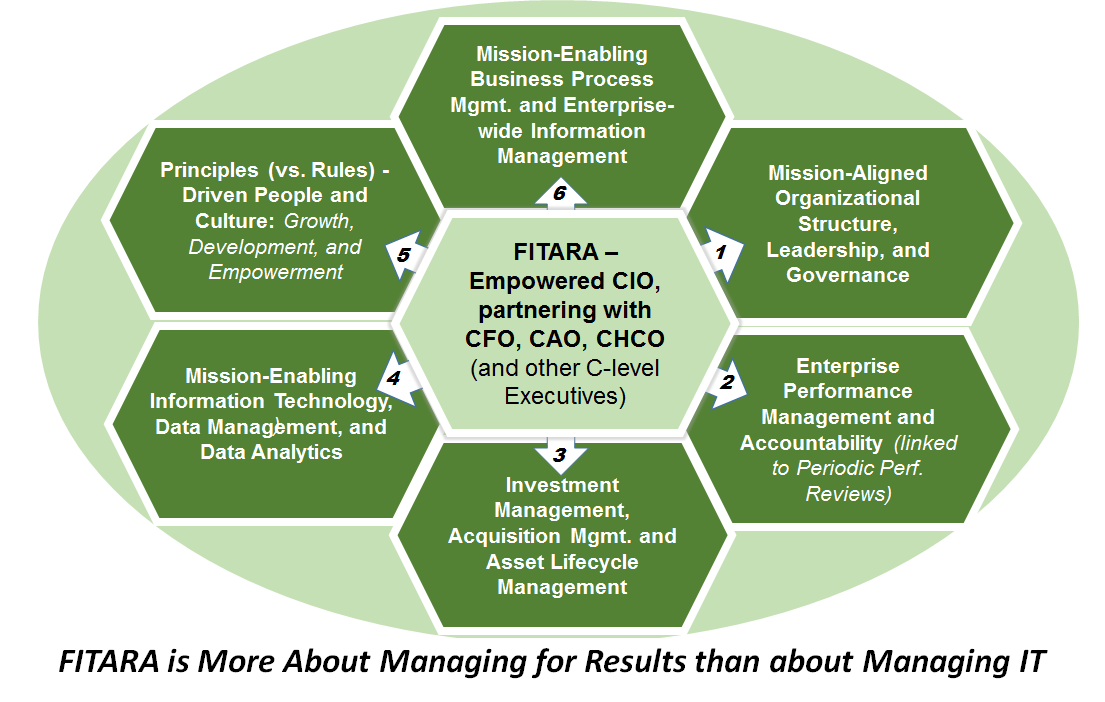“Our guidance takes major steps in ensuring CIOs have a seat at the table for technology-related budget, procurement, and workforce matters. [It] is centered on a ‘common baseline’ that outlines the roles and responsibilities for agency chief information officers and other senior agency officials. More importantly, it establishes a groundwork for productive partnerships among these leaders to make IT decisions that better support [their business] mission.” – U.S. Chief Information Officer (CIO) Tony Scott (upon releasing the final Federal Information Technology Acquisition Reform Act (FITARA) guidance from the Office of Management and Budget (OMB)
Passed by Congress in December 2014, the Federal Information Technology Reform Act (FITARA) grants more influence and control over investments in information technology (IT) to agency’s CIOs.

Though the Clinger-Cohen Act of 1996 created the CIO position and directed agencies to pay more attention to the results they could achieve through IT investments, it was enacted during an era when the idea of making IT investments on a broad scale was still relatively new – and, perhaps as a result, was seen by many to do little more than emphasize rigor and structure in how agencies select and manage IT projects. Now, with the advent of FITARA, federal CIOs are empowered to make decisions across their agency on the planning and implementation of IT projects, relating to functions such as budgeting, procurement, governance and retaining skilled personnel.
FITARA also sets an accountability-related expectation that CIOs will work hand-in-hand with the agency’s Chief Financial Officer (CFO), Chief Acquisition Officer (CAO), and its Chief Human Capital Officer (CHCO), each relying on a “Common Baseline,” to clarify roles and responsibilities of the CIO and the senior officials designated as his (or her) partners. In addition, the Act requires data center consolidation, reviews of IT Portfolios, transparent reporting on IT-investments, government-wide purchasing of software, strategic sourcing, and the maintenance of a cadre of professionals, skilled in IT and acquisitions. As illustrated below, FITARA is meant to be more about managing for (mission and business) results than about managing an agency’s information and technology.

OMB’s guidance for implementing FITARA, requires agencies to submit (to OMB) a self-assessment and FITARA implementation plan, to be updated on an annual basis, which will be made public to enhance accountability. Additionally, agencies were told that PortfolioStat will be the means by which periodic reviews of agencies’ progress will be accomplished – to help keep them compliant with the law. OMB’s FITARA guidance takes major steps to ensure that federal CIOs have a seat at their agency’s decision-making table for all technology-related budget, procurement, and workforce development matters. The common baseline, as the “backbone” of the guidance, outlines specific roles and responsibilities for CIOs and other senior agency officials. The OMB guidance also “establishes the groundwork for productive partnerships among those officials to make the best possible decisions. Like never before, federal C-level executives are being held accountable, under FITARA, for effectively managing the entire lifecycle of Information- and technology-related products and services, while also enhancing customer outcomes.
Effective implementation of FITARA by federal agencies is expected to improve IT operations, and acquisitions, by directly exposing duplicative and inefficient operational applications, systems, and other solutions that waste hundreds of millions of taxpayer-dollars every year. Better planning, transparency, and increased oversight are expected to improve overall results. While CIOs must demonstrate that they are delivering IT solutions using a comprehensive approach to reducing risks, OMB’s IT Dashboard, which highlights underperforming initiatives, exposes the need for officials to course-correct, or even terminate, investment initiatives that cannot be “recovered” or otherwise salvaged in a timely manner.
How FITARA Can Enhance the Ability to Manage for Results
1. Organizational Structure, Leadership, and Governance – Concepts of leadership and governance must be applied to strategy, policies, regulation, motivation, oversight, and partnerships designed to integrate all governmental operations. Effective leadership, organizational structure, and enterprise governance, when supported by collaborative C-level executives, can quickly become high-impact transformation enablers, which are key to preventing avoidable service failures, major disruptions, and operational degradations. This cannot be achieved without inspired leadership, skilled management, and the disciplined application of effective governance that informs decision-making and results in smarter choices, especially when leaders are confronted with zero-sum investment options. FITARA-empowered leaders can work together to develop and implement plans and policies with accountability and transparency. Such exceptional leadership, with the ability to face challenges while striving to manage for results in complex circumstances and conditions, must be practiced at all organizational levels. Authority is a role that people assume and accept because of a position; yet it is not synonymous with leadership. Leadership is about enabling people to identify and face challenges on the road to achieving desired outcomes. Facing a challenge means bringing about positive change in the way things are done. Leadership helps an organization become more successful even after its desired future-state is achieved. Effective governance is characterized by the continuous direction of needed resources, higher performance levels, and greater stakeholder participation toward the goal of achieving an agency’s mission in ways that are open, transparent, accountable, equitable, and responsive to the needs of all stakeholders, including customers, employees, and business partners. For major transformation initiatives to be successful, an agency needs effective policymaking, transparent rules, open information, and active participation by everyone – particularly its C-level executives – across the entire enterprise.
2. Enterprise Performance Management and Accountability – Every day, government agencies work to define and execute strategies to improve the delivery of customer services and benefits. Too often, however, their business processes are fraught with manual tasks, complicated spreadsheets and poorly connected communication channels. Enterprise Performance Management practices, methods, and tools can be applied to help achieve and sustain agency-wide behavioral changes and performance improvements. The fundamentals of this managing-for-results approach motivate all employees to be more responsive to customers served by their agency, by nurturing a performance-driven culture of accountability that engages every unit of the organization. It also requires improvements in enterprise- and component-level visibility to continuously assure tight alignment with, and demonstrable support for, organizational values, goals, and objectives. This need can be partly satisfied with centralized and standardized processes for monitoring the ongoing execution and impact of every initiative. This requires leaders, managers, and other employees to be held accountable (both individually and collectively) for the utilization, disposition, and replenishment of allocated resources (i.e., people, methods, processes, data, technologies, and tools), and for tracking the impact of that consumption on desired outcomes. Execution and performance gaps must be continuously identified, eliminated, or temporarily “worked-around” to assure the timely achievement of goals and outcomes. Enterprise performance management (and accountability), led by FITARA-empowered senior executives, offers a much needed means to the end of achieving even the most ambitious goals of large, transformational initiatives.
3. Investment Management, Acquisition Management, and Asset Lifecycle Management – Investment management and acquisition management activities are performed by government leaders to maintain effective stewardship of the nation’s investments in resources needed to achieve each agency’s vision, mission, and strategic goals. Any emerging resource gaps are rapidly filled to assure that mission capabilities are maintained over time, even as improvements to those capacities are simultaneously undertaken. Optimizing “corporate” investments in mission and business enablers has become more important in recent years, in a climate of declining budgets and expanding government responsibilities. This means that an ongoing assessment of each agency’s assets and how they impact the operation of that enterprise, over their entire lifecycles, needs to be made and reviewed by a council of its C-level executives to effectively plan for and manage, the operational use, maintenance, retirement (and replenishment) of enterprise investments in resources. The total cost of ownership (TCO) of any given asset is usually greater than the initial capital outlay cost, and can vary significantly among different alternative solutions to a given operational need. Consideration of the costs over the “lifetime” of each individual asset provides a solid basis for investment decision-making. A comprehensive enterprise-wide plan is needed to adequately satisfy the changing mission and business needs of government agencies, whose leaders are required to exercise sound stewardship of the public funds they consume in the discharge of their official duties. FITARA provides additional check-and-balances among each agency’s most senior executives, which should lead to significant reductions of the TCO of acquired and consumed resources, by eliminating variations in the quality and utility of products, workflows, and purchased services – and right-sizing capital investments.
4. Information Technology, Data Management, and Data Analytics – FITARA isn’t just about driving down costs. It’s about improving service delivery, while putting teeth into the acquisition process for investing in information and technology. The task of reforming such IT spending in government is now in the hands of agency CIOs. By encouraging CIOs to take a closer look at IT, the Act enables them to see where cost savings can be realized across multiple programs, exposing every aspect of acquisition to greater transparency for everyone involved. While procurement clarity motivates agencies to become more innovative, to better assure that future IT services and solutions deliver the best value for greater citizen service, the government’s demand for information and technology continues to grow. As agencies strive to modernize their operations, put more of their customer services online, and improve their information security profiles, their needs for computing power and data storage capacity have grown apace. Over recent decades, this increasing demand has led to dramatic growth in the number of federal data centers and a corresponding rise in operational costs. Concerned about the size of the federal data center inventory and the potential to improve efficiency and performance, the Federal Data Center Consolidation Initiative (FDCCI) was launched by the Federal CIO in 2010. With the enactment of FITARA four years later, agencies are required to provide annual reports to OMB now, about federal data center inventories and their new strategies to achieve consolidation, including yearly calculations of investment costs and expected savings.
5. People and Culture (Growth and Development) – As they come to terms with declining budgets, some agencies may be tempted to shift their focus away from training and career-development activities. Doing so would be a big mistake, however, during a period of large-scale organizational transformation – when opportunities for personal development and growth are among the most important factors influencing employees’ engagement and commitment to the cause. Today, employees recognize that their prospects for continued employment and career advancement depend on a certain level of confidence that their agency is well managed and headed in the right direction. An important element of building employee confidence is clarifying what employees can expect. Leaders need to help employees understand that there is a career path for success in the emerging environment and that the agency is making progress toward achieving that goal. Working across organizational lines can also help employees identify opportunities for advancement that may lie outside of their current divisions or departments. Most organizations would also benefit from better communication regarding development opportunities. In the rapidly changing environment of a major transformation, where roles and responsibilities are continually evolving, organizations must count on employees to act on their own – following established principles instead of blindly relying on hard-and-fast rules – in ways consistent with organizational cultures and values. FITARA does provide more check-and-balances among an agency’s C-level executives, which should lead to better management of a broader set of issues that impact employees’ views of their development opportunities, and helps them appreciate the fact that their engagement and empowerment contributes more to agency performance results.
6. Mission-enabling Business Processes – Understanding mission– enabling business processes, by clearly defining, analyzing, and optimizing them, is an essential step toward improving customer satisfaction. In a highly transformative environment, organizations need to readily respond to change – especially as customer expectations increase. Customers are more mobile today, and so expect high levels of service-quality regardless of where and how they engage with government. Customers also expect agencies to respond with a certain amount of personalization. It is difficult to meet these great expectations in a timely manner when core business processes and data are widely dispersed and inconsistent, as they are in many government agencies yet today. In the 21st century, government organizations need to add another core business process to the one(s) they’ve always considered mission-essential – and that is Customer Relationship Management (CRM), which should be used as a strategy for optimizing government interactions with the consumers of its products, benefits, and services. Leveraging modern technology quite heavily, CRM allows the establishment of much stronger relationships with former, current, and prospective customers, while continuous improvements are made to customer service capabilities. CRM enables FITARA-empowered leaders to ensure that customer relations are nourished in a more deliberate and strategic manner. In practice, that means developing methodologies, internal operations, software and Internet capabilities to better address customers’ needs and, as a result, make agency relationships with its customers more satisfying. By analyzing tracked customer-satisfaction data, agency leaders can always “know” the sentiments of their customers, enhance the ways they communicate with customers, reduce customer-response times, and better serve more geographic regions.
Bottom Line Considerations
FITARA should greatly help the federal government deliver major IT programs. Yet, it represents just the start of major reforms. CIOs are now being held to account for managing their mission- and business-enabling information and technology portfolios, essentially codifying into law OMB’s PortfolioStat process for identifying and correcting potentially troubled projects. FITARA also formalizes recent efforts to consolidate and close large numbers of federal data centers. At least two control mechanisms will be critical for success: (1) an enterprise governance model, which ensures a collaborative partnership among an agency’s C-level leaders, particularly as it impacts information- and technology-related acquisition strategies; and, (2) an enterprise program management organization that provides requisite skills and ensures adequate representation from various agency stakeholders, to assure operational effectiveness. OMB must ensure that these important control mechanisms are institutionalized by C-level executives in each agency, for FITARA to have its intended effects on organizational behaviors.
1)U.S. Chief Information Officer Tony Scott announced the release of the Office of Management and Budget’s final Federal Information Technology Acquisition Reform Act guidance June 10th 2015 during a Congressional hearing on ensuring success of the law.
2)Through a process called PortfolioStat – an Office of Management and Budget (OMB) initiative launched a few years ago that requires agencies to review their IT investments annually and cut duplication, among other things – agencies were supposed to save billions of dollars on IT expenditures in the ensuing years.

















